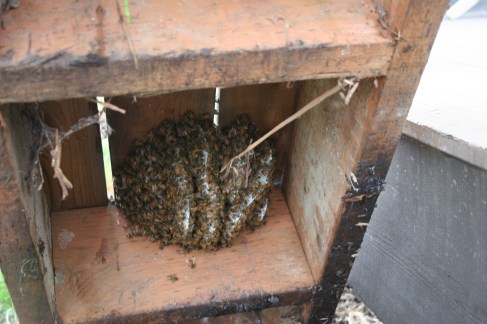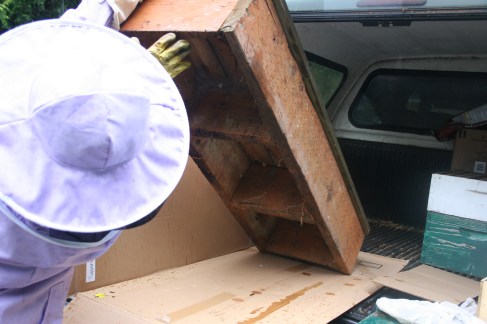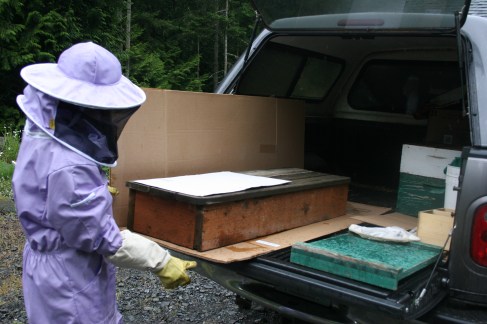
Honey bees are an integral part of the deeply-routed heritage of agriculture in the San Juan Islands. Farmers depend on these hard-working participants to bring residents and tourists alike a bountiful array of delicious and healthy fruits, vegetables, and honey every season. Beekeeping losses however, are mounting and perhaps San Juan Island residents are among the most active proponents of protecting the island ecosystems from the harmful pesticides that have been linked to bee colony collapses across the country. From conservation of farmlands to a ban of GMO’s in November 2012, islanders have shown initiative in creating a healthy and sustainable way of agriculture that translates into a healthier habitat for honey bees to weather the storm until the rest of the world follows suit.
My beekeeping journey began long before I actually got my first hive. A graduate student in entomology, I moved to San Juan Island in 2009 as a place to recover from a debilitating course of Lyme Disease. My grandfather had been a beekeeper, and I had long been inspired to find a way to pursue my dream of having my own hives. My first endeavor was unfortunately not successful. I lost my colony this past winter of starvation after a season of queen failures and a cold spring and summer. They just hadn’t stored enough food. Persistence has paid off though. I’m now a “keeper” of two bee colonies. Both are doing fantastic. I’d like to share with you my story of how I came to acquire my second hive this season. It was a day any beekeeper would feel lucky. Someone called me with bees that needed a home…
The phone call came in late June about bees under a doorstep. I was asked to come over and take a look to see if they were honey bees…if so, could I take them away! Unfortunately, the homeowner suffered from an allergy to bee stings and the bees hadn’t exactly set up housekeeping in the most desirable place.
Honey bees don’t typically colonize an area so low to the ground, so I was anticipating the occupants under the step to be yellow jackets instead. Surprisingly a quick glance at the step yielded a flying specimen that was all too easy to identify. They were indeed honey bees!
My next task would be to figure out how to remove them without causing harm to the small, but vital colony that had set up housekeeping too close to someone else’s house.


It was raining and unusually cool that day, so I decided (with the generous permission of the homeowner) to take the whole step home with me. On a day like this, the colony was huddled together to keep warm, so I was able to haul them off in my truck camper losing few, if any, of the bees.


Once home, I set the step with the bees in a little garden area and placed an empty hive box (super) on top of the step with a jar of sugar syrup to feed them. This would give me time to devise a plan to cut them out of the step and relocate them safely into a hive box.
A beekeeping friend loaned me some empty frames and I found that drawer of rubber bands I’d been saving and waited for a sunny day to get to work.
On July 9, 2013, I decided the bees had oriented themselves to their new location and now it was time to put them into a new home. With the sun overhead, I had all my tools at hand and a helpful partner.
Wearing our bee suits, we carefully turned the step on its side to inspect the honeycomb built by this little colony. There were about eight oval-shaped combs ranging in diameter from 5 to about 12 inches. The bees blanketed these sheets of comb attached to the top of the step.
One at a time, and with extreme care, I used a sharp knife to loosen the comb from the step. The wax is really pliable when it gets warm, so gentle handling is a necessity or you will squeeze it, damaging the bee brood (baby bees) and spilling out honey.
After cutting out each sheet of comb, I had my partner help me insert it into an empty frame and secure it with a rubber band. We were careful to make sure to place the comb in the same orientation it had been in when attached to the step. The bees have the cells of the comb angled just a certain way so as to keep the contents from being affected by gravity and spilling out.
Once we’d finished about three sheets of comb, I spotted the queen. She was a very healthy specimen and I wanted to make sure she didn’t fly away in all of the disturbance. Using a bee brush to gently pick her up, I moved her onto one of the newly rubber-banded frames already placed into the new hive box. Worker bees soon surrounded her, responding to her familiar pheromones and undoubtedly exploring their new surroundings.
Finishing the last few sheets of comb, I started to get really warm under all the protective bee gear. I had been observing how gentle this colony of bees seemed to be, so I decided to do the rest of the work sans my veil and gloves. Working with much more dexterity, I wasn’t stung once.
Amazingly, we were able to remove and secure each of the sheets of comb into the frames. I’m happy to say that we moved this colony with success! The bees are thriving in their new home!
How you can help honey bees too!
There’s lots of buzzing about honey bees going on in the world. Honey bees pollinate 1/3 of the food we eat! Current research is showing an undeniable decline in populations of these well-known agricultural pollinators. No longer can we ignore that the seemingly innocuous use of chemicals and pesticides found stocking the shelves in our markets are poisoning some of the smallest, but most critical links in our food chain.
You can help by eliminating or at least minimizing use of chemicals in and around your lawn and garden. Choose landscaping plants that are bee-friendly. Write your senators and express concern about the toxic products on the market. Support local organic farmers and bee-aware of your eco-footprint on the earth!
Cynthia Brast is a beekeeper and graduate entomology student living on San Juan Island. In her spare time she enjoys blogging about beekeeping and photographing pollinators to educate others about why they’re important and worth saving. Follow her on Facebook at http://www.facebook.com/talesfromthehive


























































